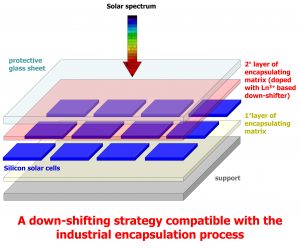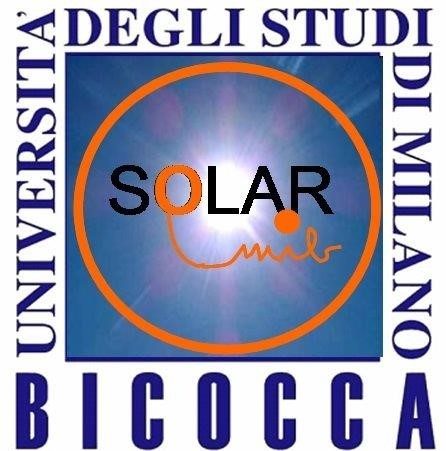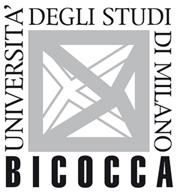It is widely known that crystalline silicon based solar cells are expected to dominate the PV market at least for the next two decades. The attention of the scientific PV community is therefore focused on several ways to increase the efficiency to cost ratio of silicon solar devices. The research activities of MIB-SOLAR Center in this field are aimed both to a material cost reduction and to an increase of the efficiency.
Material cost reduction and defects engineering
![]() Efforts were made in the past to develop processes for the purification and the use of metallurgical grade silicon feedstock, which results in the low cost but less pure solar grade silicon (SoG-Si). The use of SoG-Si could allow both for a substantial increase in the Si production able to sustain the high PV market growth rate and for a decrease of the Watt peak (Wp) cost. Our research activities in this field are devoted to the study of the effect of the impurities on the lifetime and efficiency of the SoG-Si based solar cells. Besides a variety of metallic impurities, SoG-Si often contains a large amount of the doping elements. Thereby, the effect of the compensation has to be taken into account, since this can impact solar cell performance. In our research activities, the spectroscopic and electrical features of compensated Si samples have been monitored by different techniques (Photoluminescence, Infrared spectroscopy, Hall Effect). Furthermore, considering the multicrystalline nature of the silicon used, the recombination activity of the extended defects (i.e grain boundaries and dislocations) and its dependence on the impurities content (e.g. interstitial oxygen) should also be monitored.
Efforts were made in the past to develop processes for the purification and the use of metallurgical grade silicon feedstock, which results in the low cost but less pure solar grade silicon (SoG-Si). The use of SoG-Si could allow both for a substantial increase in the Si production able to sustain the high PV market growth rate and for a decrease of the Watt peak (Wp) cost. Our research activities in this field are devoted to the study of the effect of the impurities on the lifetime and efficiency of the SoG-Si based solar cells. Besides a variety of metallic impurities, SoG-Si often contains a large amount of the doping elements. Thereby, the effect of the compensation has to be taken into account, since this can impact solar cell performance. In our research activities, the spectroscopic and electrical features of compensated Si samples have been monitored by different techniques (Photoluminescence, Infrared spectroscopy, Hall Effect). Furthermore, considering the multicrystalline nature of the silicon used, the recombination activity of the extended defects (i.e grain boundaries and dislocations) and its dependence on the impurities content (e.g. interstitial oxygen) should also be monitored.
As far as an increase of the efficiency is concerned, we investigate the origin of recombining defects in commercially available high efficiency silicon solar cells. As a matter of fact, a deeper understanding of the nature of recombining defects is mandatory to eliminate them either during the ingot formation or during the cell processing, thus allowing for an increase of the cell performance. In our studies, the electrical and optical activities of defects (mainly point defects and/or dislocations) in high purity silicon grown from CZ or FZ techniques have been investigated in detail by Microwave Photo-Conductance Decay (mW-PCD) (in collaboration with ECN), photoluminescence (PL) imaging (in collaboration with ECN and University of New South Wales) and local PL.
Light harvesting to increase Si solar cell efficiency
 Among the approaches to increase the efficiency of single junction solar cells is the light harvesting strategy. Generally, this method is based on a better exploitation of the solar spectrum regions which show no good match with the spectral response of Si PV devices. In the first place, an increase of the energy conversion efficiency of commercially available silicon solar cells could be obtained exploiting the solar spectrum component below 450 nm, this high energy tail being not efficiently converted by silicon. Our research activity in this field has been devoted to the optical and electrical characterization of commercial c-Si solar cells coated with layers doped with different Eu3+ organic complexes, able to down-shift photons with wavelength lower than 400 nm. Rare earth organic complexes present in fact the separation between the absorption and the emission bands required to obtain large Stokes shift and to avoid self-absorption losses. We have tested different commercial crystalline silicon solar cells encapsulated with Ethylene-Vinyl-Acetate layers (that is the encapsulating matrix used nowadays by the photovoltaic industry) doped with different europium complexes absorbing between 260 and 380 nm and emitting at 612 nm. Such a procedure allows an improvement of the PV conversion efficiency without modification of the industrial process leading to the fabrication of the solar modules. Significant increase of the total power delivered by such test modules has been obtained under Air Mass 1.5 conditions (simulating terrestrial applications), allowing for a reduction of the Wp price.
Among the approaches to increase the efficiency of single junction solar cells is the light harvesting strategy. Generally, this method is based on a better exploitation of the solar spectrum regions which show no good match with the spectral response of Si PV devices. In the first place, an increase of the energy conversion efficiency of commercially available silicon solar cells could be obtained exploiting the solar spectrum component below 450 nm, this high energy tail being not efficiently converted by silicon. Our research activity in this field has been devoted to the optical and electrical characterization of commercial c-Si solar cells coated with layers doped with different Eu3+ organic complexes, able to down-shift photons with wavelength lower than 400 nm. Rare earth organic complexes present in fact the separation between the absorption and the emission bands required to obtain large Stokes shift and to avoid self-absorption losses. We have tested different commercial crystalline silicon solar cells encapsulated with Ethylene-Vinyl-Acetate layers (that is the encapsulating matrix used nowadays by the photovoltaic industry) doped with different europium complexes absorbing between 260 and 380 nm and emitting at 612 nm. Such a procedure allows an improvement of the PV conversion efficiency without modification of the industrial process leading to the fabrication of the solar modules. Significant increase of the total power delivered by such test modules has been obtained under Air Mass 1.5 conditions (simulating terrestrial applications), allowing for a reduction of the Wp price.
Research team: Prof. Simona Binetti (Full Professor)
Selected publications
- A. Le Donne, S. Binetti, V. Folegatti, G. Coletti On the nature of striations in n-type silicon solar cells Applied Physics Letters 109, 033907 2016
- S. Binetti, M. Gonik, A. Le Donne, A. Croel Silicon samples grown under reduced melt convention Journal of Crystal Growth 417 2015 9–15
- Binetti S., Le Donne A., Sassella A. Photoluminescence and infrared spectroscopy for the study of defects in silicon for photovoltaic applications Solar Energy Materials & Solar Cells 130 2014 696–703
- M. Di Sabatino, S. Binetti, J. Libal, M. Acciarri, H. Nordmark and E.J. Øvrelid, Oxygen distribution on a multicrystalline silicon ingot grown from upgraded metallurgical silicon, Solar Energy Materials & Solar Cells 95 2011 529-533
- Michio Tajima, Takaaki Iwai, Hiroyuki Toyota, Simona Binetti, and Daniel Macdonald Donor - acceptor pair luminescence in compensated Si for solar cells Journal of Applied Physics 110 2011 043506
- R.Slunjski, I.Capan, B.Pivac, A.Le Donne, and S.Binetti Effects of low-temperature annealing on polycrystalline silicon for solar cells Solar Energy Materials & Solar Cells 95 2011 559-563
- M.Tajima, T. Iwai, H. Toyota, S. Binetti, D. Macdonald Fine Structure Due to Donor–Acceptor Pair Luminescence in Compensated Si Appl. Phys. Express 3 2010 071301 .
- U. Cosentino, C. Greco, D. Pitea, S. Binetti, A. Le Donne, G. Moro, A. Baiardi, Theoretical and experimental investigation of UV–Vis absorption spectrum in a Eu(3+) based complex for luminescent downshifting applications Theor Chem Acc 136, 117 2017
- E. Moretti, A. Talon, L. Storaro, A. Le Donne, S. Binetti, A. Benedetti, S. Polizzi Concentration quenching and photostability in Eu(dbm)3phen embedded in mesoporous silica nanoparticles Journal of Luminescence 146, 178–185, 2014
- A. Le Donne and S. Binetti “Solar spectrum modification to enhance silicon solar cells efficiency” Handbook of Silicon Photonics, Ed. L. Pavesi-L. Vivien, CRC press, 2013
- S. Binetti, M.Acciarri, A. Le Donne, M. Morgano, Y Jestin Key Success Factors and Future Perspective of Silicon-Based Solar Cells International Journal of Photoenergy, vol. 2013 Article ID 249502, 6 pages, 2013
- A. Le Donne, S. K. Jana, S. Banerjee, S. Basu and S. Binetti Optimized luminescence properties of Mn doped ZnS nanoparticles for photovoltaic applications J. Appl. Phys. 113, 014903, 2013
- S. K. Jana , A. Le Donne and S. Binetti Enhancement of silicon solar cell p erformances due to light trapping by colloidal metal nanoparticles Journal of Physics and Chemistry of Solids volume 73, issue 2, 143 – 147, 2012
- A. Le Donne, M. Dilda, M. Crippa, M. Acciarri and S. Binetti " Rare earth organic complexes as down-shifters to improve Si-based solar cell efficiency Optical Materials 33, 1012–1014, 2011
- A. Le Donne, M. Acciarri, D. Narducci, S. Marchionna, and S. Binetti, Encapsulating Eu3+ Complex Doped Layers to Improve Si-based Solar Cell Efficiency Prog. Photovolt: Res. Appl. 17, 519, 2009

 '
'